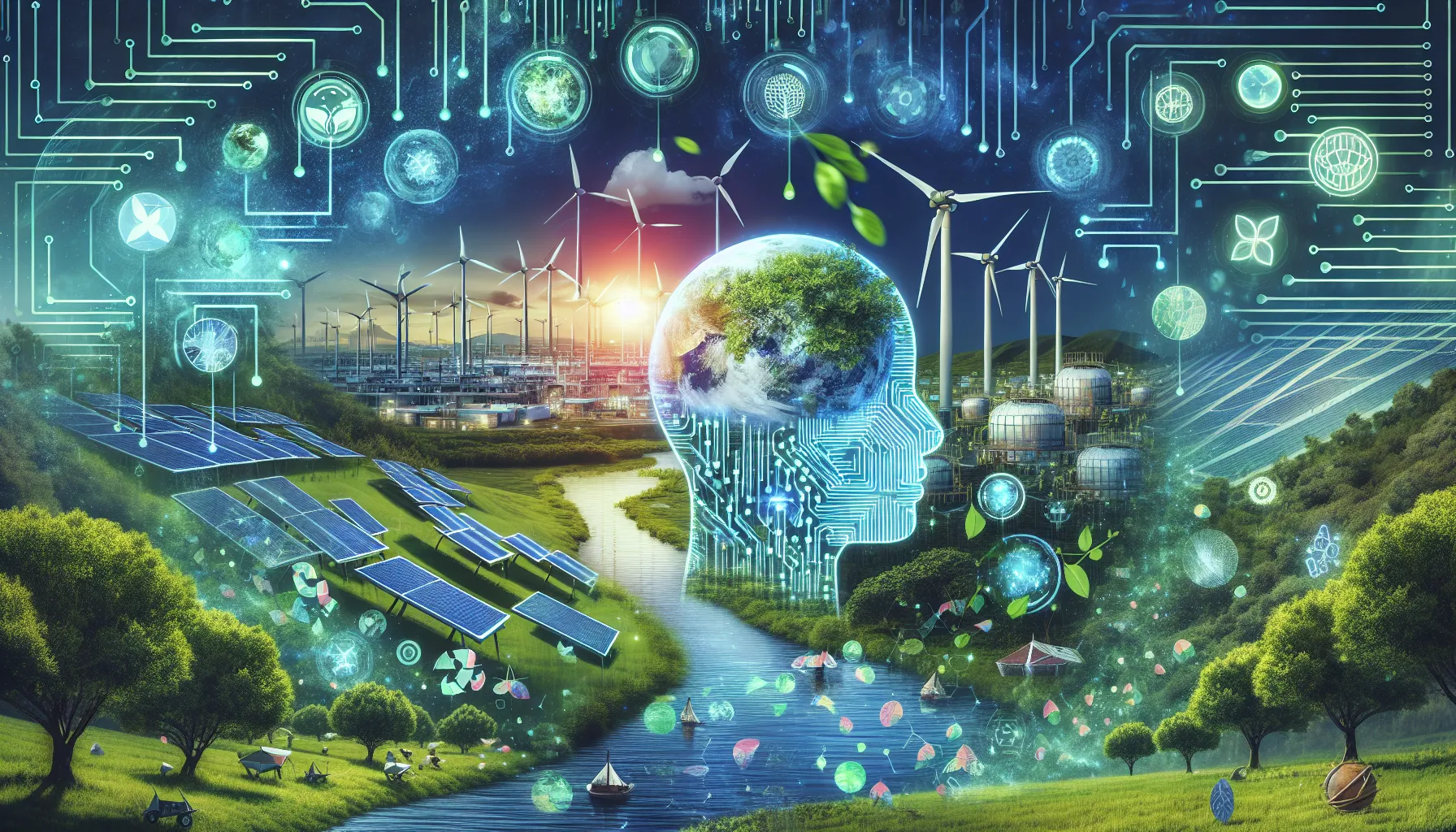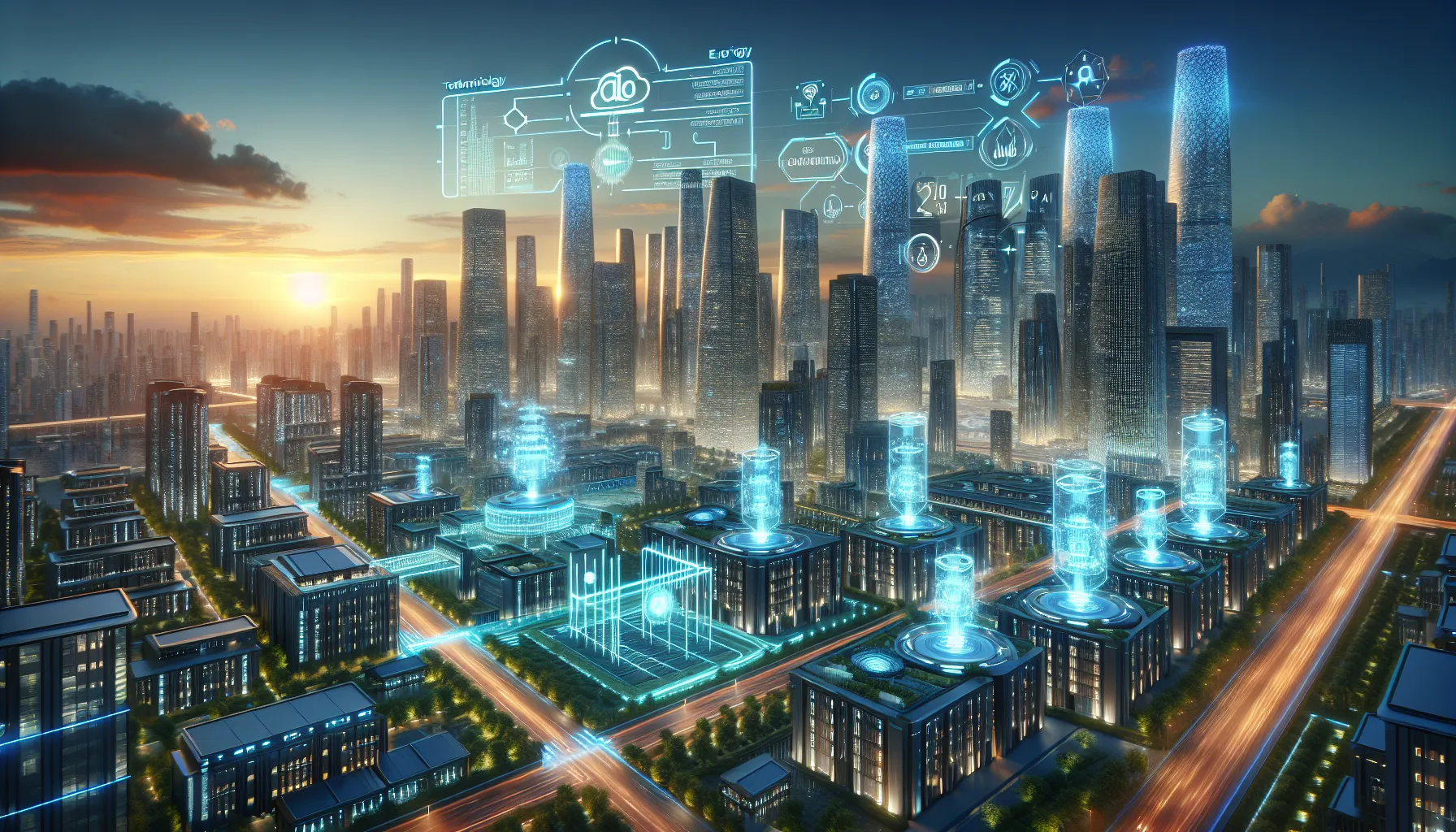Welcome to our IELTS Reading practice session focused on the fascinating topic of “AI in Solving Climate Change”. As an experienced IELTS instructor, I’ve crafted this comprehensive practice test to help you sharpen your reading skills while exploring how artificial intelligence is being leveraged to address one of the most pressing issues of our time.
 AI Climate Solutions
AI Climate Solutions
Introduction
Climate change is a global challenge that requires innovative solutions. Artificial Intelligence (AI) has emerged as a powerful tool in the fight against climate change, offering new ways to analyze data, predict outcomes, and optimize resource use. This IELTS Reading practice test will examine various aspects of AI’s role in tackling climate change, providing you with an opportunity to enhance your reading comprehension skills while learning about this crucial subject.
IELTS Reading Test: AI in Solving Climate Change
Passage 1 – Easy Text
The Promise of AI in Climate Change Mitigation
Artificial Intelligence (AI) is rapidly becoming a game-changer in the global effort to combat climate change. As the world grapples with rising temperatures, extreme weather events, and the need for sustainable development, AI offers innovative solutions that can help mitigate the impacts of climate change and accelerate the transition to a low-carbon future.
One of the most promising applications of AI in climate change mitigation is in the field of energy management. Machine learning algorithms can analyze vast amounts of data from smart grids, weather patterns, and energy consumption habits to optimize energy distribution and reduce waste. For instance, AI-powered systems can predict peak demand times and adjust energy production accordingly, ensuring a more efficient use of resources and reducing reliance on fossil fuels.
In the transportation sector, AI is driving the development of autonomous vehicles and intelligent traffic management systems. These technologies have the potential to significantly reduce carbon emissions by optimizing routes, reducing congestion, and improving fuel efficiency. Additionally, AI is being used to design more aerodynamic vehicles and develop new, lightweight materials that can further enhance fuel economy.
Agriculture, a significant contributor to greenhouse gas emissions, is another area where AI is making a substantial impact. Precision farming techniques, enabled by AI and satellite imagery, allow farmers to optimize crop yields while minimizing the use of water, fertilizers, and pesticides. This not only reduces the environmental impact of agriculture but also helps ensure food security in the face of changing climate conditions.
AI is also playing a crucial role in climate modelling and prediction. By analyzing complex climate data, AI systems can provide more accurate forecasts of climate trends and extreme weather events. This information is invaluable for policymakers and urban planners in developing strategies to adapt to and mitigate the effects of climate change.
As we continue to harness the power of AI in addressing climate change, it is clear that this technology has the potential to revolutionize our approach to environmental sustainability. By enabling smarter decision-making, more efficient resource use, and innovative solutions to complex problems, AI is proving to be an indispensable ally in the fight against climate change.
Questions 1-7
Do the following statements agree with the information given in the passage?
Write:
TRUE if the statement agrees with the information
FALSE if the statement contradicts the information
NOT GIVEN if there is no information on this
- AI is considered a revolutionary tool in addressing climate change.
- Machine learning algorithms can only analyze data from smart grids.
- AI-powered systems can predict peak energy demand times.
- Autonomous vehicles are already widely used in public transportation.
- Precision farming techniques help reduce the use of water and chemicals in agriculture.
- AI systems can provide 100% accurate climate predictions.
- The use of AI in climate change mitigation is limited to the energy sector.
Questions 8-10
Complete the sentences below.
Choose NO MORE THAN TWO WORDS from the passage for each answer.
- AI is helping to develop ___ and intelligent traffic management systems in the transportation sector.
- ___ techniques in agriculture are enabled by AI and satellite imagery.
- AI systems analyze complex climate data to provide more accurate ___ of climate trends and extreme weather events.
Passage 2 – Medium Text
AI-Driven Innovations for a Sustainable Future
The integration of Artificial Intelligence (AI) into climate change solutions has ushered in a new era of environmental stewardship. As the global community grapples with the multifaceted challenges posed by climate change, AI technologies are emerging as powerful tools for developing sustainable practices and mitigating environmental impacts across various sectors.
One of the most promising applications of AI in the fight against climate change is in the realm of renewable energy optimization. Advanced machine learning algorithms are being employed to enhance the efficiency of solar and wind farms by predicting weather patterns and adjusting energy production accordingly. These AI-driven systems can analyze vast amounts of data from multiple sources, including satellite imagery, weather stations, and historical records, to optimize the placement of renewable energy infrastructure and maximize energy output.
Moreover, AI is revolutionizing the field of carbon capture and storage (CCS). Traditional CCS methods have been hindered by high costs and technical limitations, but AI is helping to overcome these obstacles. By utilizing deep learning techniques, researchers are developing more efficient carbon capture materials and processes. AI models can simulate thousands of potential molecular structures to identify those most effective at trapping carbon dioxide, significantly accelerating the discovery of novel materials for CCS applications.
In the realm of urban planning and development, AI is facilitating the creation of smart cities that are more resilient to climate change impacts. Machine learning algorithms can analyze urban data to optimize energy consumption in buildings, improve waste management systems, and enhance public transportation networks. For instance, AI-powered traffic management systems can reduce congestion and lower emissions by dynamically adjusting traffic signals based on real-time traffic flow.
The agricultural sector, a significant contributor to greenhouse gas emissions, is also benefiting from AI-driven innovations. Precision agriculture techniques, enabled by AI and Internet of Things (IoT) devices, allow farmers to optimize crop yields while minimizing resource use. AI algorithms can analyze soil conditions, weather patterns, and crop health data to provide precise recommendations for irrigation, fertilization, and pest control, thereby reducing water consumption and the use of harmful chemicals.
In the field of climate science, AI is enhancing our understanding of complex climate systems and improving the accuracy of climate models. Neural networks and other machine learning techniques are being used to analyze vast datasets of climate information, identifying patterns and relationships that may be overlooked by traditional statistical methods. This improved modeling capability allows scientists to make more accurate predictions about future climate scenarios and assess the potential impacts of different mitigation strategies.
However, the application of AI in climate change solutions is not without challenges. Ethical considerations, such as data privacy and the potential for bias in AI algorithms, must be carefully addressed. Additionally, the energy consumption of AI systems themselves must be taken into account to ensure that the benefits of these technologies outweigh their environmental costs.
Despite these challenges, the potential of AI to accelerate progress in climate change mitigation and adaptation is immense. As AI technologies continue to evolve and become more sophisticated, they will play an increasingly crucial role in shaping a sustainable future for our planet. By harnessing the power of AI, we can develop more effective strategies to combat climate change, preserve biodiversity, and create a more resilient global ecosystem.
Questions 11-15
Choose the correct letter, A, B, C, or D.
-
According to the passage, AI is being used in renewable energy to:
A. Replace traditional energy sources
B. Predict weather patterns
C. Build new solar and wind farms
D. Reduce energy consumption -
The use of AI in carbon capture and storage is primarily focused on:
A. Reducing the cost of CCS methods
B. Developing new carbon capture facilities
C. Identifying effective carbon-trapping materials
D. Simulating climate change scenarios -
In smart cities, AI-powered traffic management systems aim to:
A. Increase the number of vehicles on the road
B. Replace public transportation
C. Reduce traffic congestion and emissions
D. Install more traffic signals -
Precision agriculture techniques enabled by AI help farmers to:
A. Increase the use of fertilizers
B. Maximize crop yields while minimizing resource use
C. Eliminate the need for irrigation
D. Grow only organic crops -
The passage suggests that one challenge in using AI for climate change solutions is:
A. The lack of available data
B. The high cost of implementation
C. The potential for bias in AI algorithms
D. The resistance from traditional industries
Questions 16-20
Complete the summary below.
Choose NO MORE THAN TWO WORDS from the passage for each answer.
AI is playing a crucial role in addressing climate change across various sectors. In renewable energy, AI uses (16) to optimize the placement and operation of solar and wind farms. For carbon capture and storage, AI accelerates the discovery of new materials through (17) . In urban planning, AI contributes to the development of (18) that are more resilient to climate change impacts. The agricultural sector benefits from AI through (19) techniques, which help optimize crop yields while reducing resource use. In climate science, AI enhances climate modeling using techniques such as (20) ___ to analyze vast datasets and improve prediction accuracy.
Passage 3 – Hard Text
The Symbiosis of AI and Climate Science: Challenges and Opportunities
The intersection of Artificial Intelligence (AI) and climate science represents a frontier of innovation in the global effort to understand and mitigate climate change. This synergy has the potential to revolutionize our approach to environmental challenges, offering unprecedented insights and solutions. However, the integration of AI into climate science also presents a complex landscape of opportunities and challenges that must be carefully navigated.
One of the most significant contributions of AI to climate science lies in its capacity to process and analyze vast and heterogeneous datasets. Climate systems are inherently complex, involving interactions between the atmosphere, oceans, land surfaces, and human activities. Traditional analytical methods often struggle to capture the full complexity of these systems. AI, particularly machine learning algorithms, can identify patterns and relationships in climate data that might elude human researchers. For instance, deep learning models have been employed to improve the accuracy of climate predictions by analyzing historical climate data alongside current observations, leading to more refined projections of future climate scenarios.
Moreover, AI is enhancing our ability to monitor and quantify greenhouse gas emissions with greater precision. Satellite imagery analysis, augmented by AI algorithms, allows for real-time tracking of deforestation, urban expansion, and industrial emissions. This capability is crucial for verifying compliance with international climate agreements and identifying areas where intervention is most urgently needed. AI-driven systems can also optimize the placement and operation of ground-based sensors, creating a more comprehensive and accurate global emissions monitoring network.
In the realm of climate adaptation, AI is proving invaluable in developing resilience strategies for communities facing climate-related risks. By analyzing data on topography, infrastructure, and historical weather patterns, AI models can predict areas most vulnerable to flooding, heat waves, or other extreme weather events. This information enables urban planners and policymakers to implement targeted adaptation measures, such as improving drainage systems or creating green spaces to mitigate urban heat island effects.
The application of AI in climate science extends to the development of climate-responsive technologies. For example, AI is being used to design more efficient renewable energy systems, optimize smart grids to reduce energy waste, and create new materials for carbon capture and storage. These innovations are critical in transitioning to a low-carbon economy and achieving global climate goals.
However, the integration of AI into climate science is not without its challenges. One significant concern is the energy consumption of AI systems themselves. The training and operation of large AI models require substantial computational resources, which can have a considerable carbon footprint. This paradox – using energy-intensive technology to solve energy-related problems – necessitates careful consideration of the net environmental impact of AI applications in climate science.
Another challenge lies in the interpretability of AI models. While these models can process vast amounts of data and identify complex patterns, their decision-making processes are often opaque. This “black box” nature can be problematic in the context of climate science, where transparency and reproducibility are crucial for building trust in scientific findings and informing policy decisions.
Data quality and availability present additional hurdles. AI models are only as good as the data they are trained on, and climate data can be inconsistent, sparse, or biased. Ensuring the accuracy and representativeness of data inputs is essential for developing reliable AI-driven climate models and solutions.
Furthermore, there are ethical considerations surrounding the use of AI in climate science. Questions of data ownership, privacy, and the potential for AI to exacerbate existing inequalities in climate vulnerability and adaptation capabilities must be addressed. There is also a risk of over-reliance on AI solutions, potentially diverting attention and resources from other necessary climate action measures.
Despite these challenges, the potential benefits of integrating AI into climate science far outweigh the drawbacks. To fully harness this potential, a multidisciplinary approach is essential. Collaboration between climate scientists, AI researchers, policymakers, and ethicists is crucial to develop AI solutions that are not only technologically advanced but also environmentally sustainable, ethically sound, and socially equitable.
As we stand at the crossroads of technological innovation and environmental imperative, the symbiosis of AI and climate science offers a powerful tool in our arsenal against climate change. By addressing the challenges and leveraging the opportunities presented by this integration, we can enhance our understanding of climate systems, improve our predictive capabilities, and develop more effective strategies for mitigation and adaptation. The future of climate action may well depend on our ability to harness the power of AI responsibly and effectively in service of our planet’s sustainability.
Questions 21-26
Complete the sentences below.
Choose NO MORE THAN TWO WORDS from the passage for each answer.
- AI’s ability to process ___ is one of its most significant contributions to climate science.
- ___ enhanced by AI algorithms allows for real-time tracking of deforestation and industrial emissions.
- AI models can predict areas most vulnerable to ___ by analyzing various types of data.
- The ___ of AI models can be problematic in climate science, where transparency is crucial.
- Ensuring the ___ of data inputs is essential for developing reliable AI-driven climate models.
- A ___ is essential to fully harness the potential of integrating AI into climate science.
Questions 27-30
Do the following statements agree with the claims of the writer in the passage?
Write:
YES if the statement agrees with the claims of the writer
NO if the statement contradicts the claims of the writer
NOT GIVEN if it is impossible to say what the writer thinks about this
- AI can identify patterns in climate data that human researchers might miss.
- The energy consumption of AI systems is a minor concern in their application to climate science.
- AI models always provide clear explanations for their decision-making processes.
- Collaboration between various disciplines is necessary for developing effective AI solutions for climate science.
Questions 31-35
Choose the correct letter, A, B, C, or D.
-
According to the passage, one of the main advantages of using AI in climate science is its ability to:
A. Replace human researchers entirely
B. Process and analyze complex datasets
C. Predict future climate changes with 100% accuracy
D. Solve all climate-related problems independently -
The passage suggests that AI-driven systems for emissions monitoring can:
A. Completely eliminate greenhouse gas emissions
B. Replace international climate agreements
C. Help verify compliance with climate agreements
D. Directly reduce industrial emissions -
In the context of climate adaptation, AI is described as:
A. A tool for predicting vulnerable areas
B. A replacement for urban planning
C. The only solution for climate-related risks
D. Ineffective in developing resilience strategies -
The “black box” nature of AI models in climate science is problematic because:
A. It makes the models less accurate
B. It requires more computational power
C. It can undermine trust in scientific findings
D. It is impossible to improve -
The passage concludes that the integration of AI into climate science:
A. Is too challenging to be worthwhile
B. Should be avoided due to ethical concerns
C. Offers significant potential benefits despite challenges
D. Will solve all climate-related issues in the near future
Answer Key
Passage 1 – Easy Text
- TRUE
- FALSE
- TRUE
- NOT GIVEN
- TRUE
- FALSE
- FALSE
- autonomous vehicles
- Precision farming
- forecasts
Passage 2 – Medium Text
- B
- C
- C
- B
- C
- advanced machine learning algorithms
- deep learning techniques
- smart cities
- precision agriculture
- neural networks
Passage 3 – Hard Text
- vast and heterogeneous datasets
- Satellite imagery analysis
- extreme weather events
- interpretability
- accuracy and representativeness
- multidisciplinary approach
- YES
- NO
- NO
- YES
- B
- C
- A
- C
- C
Conclusion
This IELTS Reading practice test on “AI in Solving Climate Change” has provided you with an opportunity to enhance your reading comprehension skills while exploring a crucial contemporary topic. By engaging with texts of varying difficulty levels, you’ve practiced different question types and strategies essential for success in the IELTS Reading section.
Remember, consistent practice is key to improving your IELTS performance. Continue to explore diverse topics and challenge yourself with different question formats. If you’re interested in further expanding your knowledge on environmental issues, you might find our article on [the role of education in promoting


